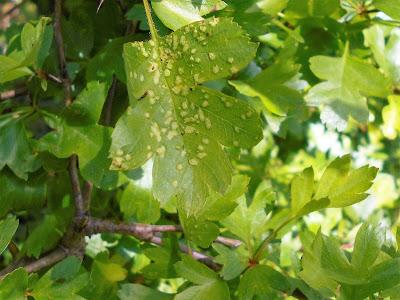The day was on the cool side and rather breezy, but thankfully dry. It was the breeze that made me plump for Byfield Pool, guessing that the tree cover would make conditions calmer. The down side was that the limited sunshine was barely able to penetrate to the ground.
We approached the pool via the retaining wall of Boddington Reservoir, where Winter Cress, Barbarea vulgaris, was in bloom.
 |
| Winter Cress growing beside Boddington Reservoir. 30 April, 2017 |
The plant was once called Herb St Barbara, explaining the Latin name for the genus. It is frequent beside streams throughout Northamptonshire.
It is that time of the year when the St Mark's Fly, Bibio marci, comes to our attention. The adults generally appear around St Mark's Day, 25 April, but with climate warming (Fake news!) the species would make a good subject for phenological studies.
 |
A male St Mark's Fly at Byfield Pool. 30 April, 2017.
Note the apparent fuzziness of the eyes caused by the presence of long hairs.
|
The species has long had a reputation as a useful pollinator of fruit trees and more recent researches suggest that crops of oilseed rape also benefit from its visits.
Several dock plants had red blotches on their leaves, suggesting that a soothing ointment should be applied. In fact it was Dock Rust, Puccinia phragmitis, with pale crusty pustules on the under side of the leaf.
Several dock plants had red blotches on their leaves, suggesting that a soothing ointment should be applied. In fact it was Dock Rust, Puccinia phragmitis, with pale crusty pustules on the under side of the leaf.
 |
Dock Rust on the leaves of Wood Dock, Rumex sanguineus.
Byfield Pool, 30.iv.2017
|
This fungus frequently occurs on rhubarb but is not a problem. It has also been known to attack Japanese Knotweed but is apparently not being considered seriously as a form of control.
The leaves of Blackthorn, Prunus spinosa, were also under attack, this time from mites. The culprit may be Eriophyes similis although Phyllocoptes eupadi seems, on balance, to be a more likely candidate. I should have brought a specimen home for microscopic examination although even then I probably wouldn't have been able to put a name to them - 'a three-pipe problem, Watson'.
The leaves of Blackthorn, Prunus spinosa, were also under attack, this time from mites. The culprit may be Eriophyes similis although Phyllocoptes eupadi seems, on balance, to be a more likely candidate. I should have brought a specimen home for microscopic examination although even then I probably wouldn't have been able to put a name to them - 'a three-pipe problem, Watson'.
 |
Phyllocoptes eupadi? on blackthorn leaves. Byfield Pool.
30.iv.2017
|
These observations are all very well but my main targets were spiders and bugs - by which I mean true bugs. In the event I took only two species of spider, both vey common, and one harvestman, also a very common species. And no bugs at all! I intend to return within a few days for a more intensive search.
















































